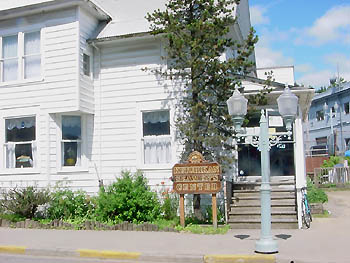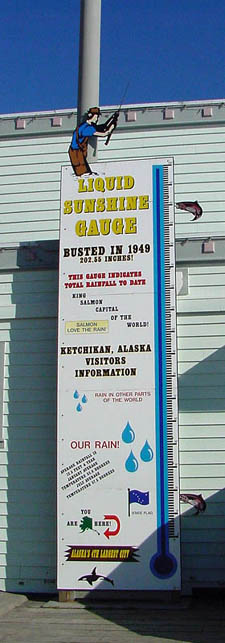 By June Allen July 10 2002
His magazine office and his Alaska Specialties novelty shop were located in the old 1904 Yates hospital on Mission Street - now the Seamen's Center. The Rain Gauge that stands
But those things are not necessarily
what Emery Tobin is remembered for. Emery's claim to fame is
that he is said to be the man who spearheaded the closure of
the city's red-light districts in 1953, ending 50 years of openly
tolerated prostitution in Ketchikan, Alaska! He became a hero
to some and an arch villain to others. It was during that contentious
crusade that Emery kept a pistol at hand on his desk. Even into his sixties Emery was fearless. When a young man shoplifted something and departed running from Emery's Alaska Specialties shop on Mission Street, Emery took off after him, legs and arms pumping. He tackled the miscreant to the wet sidewalk in front of the entrance to St. John's Church and pinned him there until help arrived. Some of Emery Tobin's spirit and determination must have come directly from his father. Emery Fridolf Tobin was born to August and Emma Tobin, Swedish immigrants, on Dec. 14, 1895, in Quincy, Mass., ten miles south of Boston. August Tobin was a painting contractor, working for the school district. The great Depression of 1893 had affected everyone. Tobin's customers owned him money and Tobin owed money to his own creditors. Times were hard. Two years after Emery's birth,
in 1897, news of the Klondike Gold Rush circled the globe, and
among those infected with gold fever were August Tobin and his
brother-in-law - Emma's brother. The two couples were close and
had been married at a double wedding. Each little family had
two children - the eldest of the four babies not yet two years
old. The two fathers decided that one would have to stay and
care for both wives and all four children; the other would go
to Alaska, make a fortune and return in a year to Quincy. At
least that was the plan. So the men drew straws and August drew
the long straw for Alaska. Emery loved to tell this story. He
would lean back in his squeaky oak desk chair and his face was
all smiles as he related his family's history.
The group recovered an old schooner that had been lying on the beach at Tacoma for many years and were determined to make it suitable for the voyage to Cook Inlet, their destination of choice. The gold claims along Turnagain Arm from Indian to Hope were said to be rich and the area far less crowded than Dawson and the Klondike. The Pennsylvania men knew a lot about farming but nothing about sailing, Emery explained. His young father who orignally hailed from Sweden knew a little bit about boats but not much. He knew a lot about painting, however, and painted the vessel stem to stern, lettering the name Elemina Johnson on the bow. The schooner looked pretty good. At this point in the story, Emery was chuckling as he told what happened next. One of their number looked a little like Christopher Columbus, so he was chosen to be captain. And once the boat was floated, the men climbed aboard and set off for the north. None of them, however, knew how to navigate. But off they sailed, laden with supplies and confidence, expecting to reach their destination in about two weeks. Three stormy months later the ship and its passengers had not been sighted and were given up for lost. But the word had gone out to keep an eye open for the Elemina Johnson in Alaska waters. The famous Alaska revenue cutter Bear rescued the argonauts, whose broken rudder was hanging loose on the stern of the vessel, and towed the crippled boat into the closest port, Dutch Harbor on Unalaska Island in the Aleutians, a far cry from Cook Inlet! Some of the Gold Rushers decided to give up and head home, but Tobin, Morton and another man chose to be put ashore at the mouth of the Kuskokwim River, north of Bristol Bay. From there they hiked up the river into the mainland, stopping to pan at a number of rich placer operations. Finally they prospected the Interior, crossed the Yukon and ended up some twenty years later in Wiseman in the Brooks Range. As it turned out, the elder Tobin did not return to Quincy after one year as planned. In fact, he returned only once in the next twenty years, promising in each letter, "Next year I'll be home." He sent many letters and as he read them, son Emery, too, was lured by the novelty and excitement of Alaska. He had finished school, worked for a time as a reporter, and served as company clerk of an infantry company in France. After the Armistice, he made plans to come to Alaska, securing employment at New England Fish Co. on the south edge of Ketchikan. It was 1920 and Emery was 25 years old. His father August was had also arrived in Ketchikan shortly before, having stopped en route as "he worked his way south," Emery explained. In time Emery's mother and sister came to Ketchikan and the family was reunited. When they died two decades later, August and Emma were buried side by side at Bayview Cemetery, "forever in Alaska." To the end of his life, Emery proudly referred to his father as "a jolly old Sourdough." Emery became a reporter for
the Ketchikan Chronicle for a few years and gained additional
experience for what would be one of his crowning achievements,
the creation of the Alaska Sportsman magazine. He and several
others - including popular local artist Bill Gabler and well
known resident Ray Roady - formed a corporation to publish a
magazine that focused on stories about hunting, fishing and adventure
in Alaska plus editorials that addressed Alaska's political challenges.
It would soon find an audience across the nation. In 1935 the
first monthly issue was published and then there was a lapse
until the second issue came. But from that time on, Alaska Magazine
- the name changed when Tobin sold it in 1966 - has published
every month since.
Next: The history of prostitution in Ketchikan, its extent, and Tobin's role in the closure.
Photos by Gigi Pilcher & Dick Kauffman
|
|||

